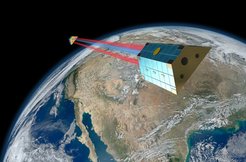Successful launch of the climate research mission GRACE Follow-On
Satellite pair with novel laser interferometer from Hannover reaches Earth orbit
On 22nd of May, 2018 at 12:47 local time (21:47 CEST) the GRACE Follow-On satellite duo was launched into space with a Falcon 9 rocket from Vandenberg Air Force Base in California. GRACE Follow-On is a joint project of NASA with German partners, which are led by the German Research Centre for Geosciences. It will continue the successful GRACE mission, which ended in 2017: precisely measuring the Earth’s gravity field and its changes to observe indicators of climate change. A laser interferometer on board developed under lead of the Max Planck Institute for Gravitational Physics (Albert Einstein Institute; AEI) will significantly increase the measurement precision. The interferometer is the first such instrument between two satellites in space. It is not only meant to be a pilot project for similar future missions, but also a pilot project for LISA, the planned gravitational-wave observatory in space.
“I am relieved that the launch went perfect. In a few days we will switch on the laser interferometer from Oberpfaffenhofen and soon after that establish the laser link between the two satellites. This is going to be very exciting!” says Prof. Gerhard Heinzel, leader of the space interferometry research group at the AEI and manager of the German contribution to the Laser Ranging Interferometer (LRI).
“The LRI is a premiere: the first laser interferometer between two satellites over a distance of 220 kilometers in space. It is not only meant to measure the Earth’s gravity field more precisely, but will also be a pilot project for future missions. The technology was developed for the gravitational-wave observatory LISA, and in turn LISA will profit from our experiences with the LRI,” adds Prof. Karsten Danzmann, director at the AEI and director of the Institute for Gravitational Physics at Leibniz Universität Hannover.
Two satellites study Earth’s gravity field

After the launch from Vandenberg, California the rocket released the satellites after ten minutes 450 kilometers above the surface of the Earth. Both GRACE Follow-On satellites follow one another in a distance of 220 kilometers in this 90-minute orbit. While it takes the satellites above Earth’s poles, the planet rotates below the pair of satellites so that over time they fly over the entire surface of Earth.
The satellites continuously register their distance with high precision. The fine structure of the Earth’s gravity field modulates this distance. During, e.g., flying over the Himalayas the distance changes by 40 millionths of a meter. To detect such tiny effects, a microwave interferometer similar to radar has been used so far. The new laser interferometer onboard GRACE Follow-On will significantly increase the measurement precision (thanks to the shorter wavelength of the radiation used).
Precise measurements with a novel laser interferometer
This allows to study Earth’s gravity field in the future and track its changes over time even more precisely. These observations have many applications, especially in climate research. Melting of ice sheets in Greenland and the Antarctic, rising sea levels, changing groundwater levels, droughts and floods can thus be observed from space. The data also play an important role in defining the geoid, which is at the base of height measurements.
First observational data in the summer of 2018
GRACE Follow-On will deliver first observational data in the summer of 2018. Geodesists and climate researchers wait for them desperately. Among them are members of the Deutsche Forschungsgemeinschaft’s Collaborative Research Centre geo-Q at the AEI and the Institute of Geodesy at Leibniz Universität Hannover. For the past two years, researchers at these institutions have prepared the analysis of the novel data from the laser instrument.
“The planned mission duration of GRACE Follow-On is five years. But we hope that it will work for much longer time – like its predecessor GRACE did for 15 years,” says Heinzel
“We are very excited to see how the laser instrument performs in space. In our labs we obviously could not test the operation of the laser link of 220 kilometers in the free fall of space. We will meticulously analyze the observational data to learn from them for future missions and for the space-borne gravitational-wave observatory LISA, which is scheduled to launch in 2034 as an ESA mission,” explains Danzmann.
Background information after the page break
Background information
GRACE Follow-On is a joint project of NASA and German partners led by the German Research Centre for Geosciences. It is the improved successor to the successful GRACE mission which operated from 2002 to 2017.
The LRI is a cooperation between NASA and German partners, with the German contribution led by the AEI. The LRI concept, its prototypes and technical specifications were done at the AEI. AEI researchers have been heavily involved in developing and testing the flight hardware. The development of the LRI is based on a longstanding partnership between AEI and NASA’s Jet Propulsion Laboratory. If the laser instrument stands the test future missions could rely solely on the more precise laser interferometers instead of microwave interferometers.
The German contributions to the LRI include the entire optical system, consisting of a steering mirror, built by Hensoldt (previously Zeiss) in Oberkochen and the optical bench from SpaceTech GmbH in Immenstaad, opto-electronics from the German Aerospace Center (DLR) in Berlin-Adlershof, and electronic systems from Apcon AeroSpace & Defence in Neubiberg near Munich. SpaceTech GmbH is responsible for the industrial part of the entire German LRI contribution. The DLR Institute of Space Systems in Bremen developed and delivered calibration and testing instruments. Both satellites were built on behalf of NASA by Airbus Defence & Space in Immenstaad. Mission control for GRACE Follow-On is the German Space Operations Centre (GSOC) in Oberpfaffenhofen near Munich.












